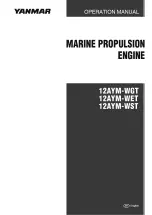
❐
Verificare l’assenza di tensione nell’impian-
to prima di procedere al collegamento elet-
trico del motore.
❐
Verificare che i cavi elettrici non siano stati
danneggiati durante il montaggio, disposti
lontano da parti in movimento e che non
debbano tenere sforzi meccanici.
❐
Chiudere tutti gli sportelli e il coperchio
della scatola morsettiera prima di alimenta-
re elettricamente per portare in rotazione il
motore.
❐
Le superfici dei motori potrebbe raggiunge-
re o superare i 100°C, quindi non posizio-
nare vicino al motore parti che si potrebbe-
ro deteriorare o incendiare a queste tem-
perature.
❐
Sollevare e/o spostare i motori utilizzando
solamente i golfari montati sul motore.
❐
Non porre parti del corpo in prossimità
delle parti in rotazione (es.: albero motore).
❐
Utilizzare adeguati dispositivi di protezione
individuale durante le lavorazioni in prossi-
mità dell’estremità d’asse (presenza di spi-
goli taglienti nella sede linguetta).
❐
Prima di eseguire il collaudo della macchina
prevedere adeguate protezioni attorno alle
parti in rotazioni (giunti, ecc.).
❐
Controllare il fissaggio delle viti o dadi delle
morsettiere elettriche prima di procedere al
collaudo del motore.
❐
Verificare anche le viti per il fissaggio del
motore nella forma costruttiva B3, B5, B35,
V1, V3…
❐
Non utilizzare il motore come base d’appog-
gio per persone o per parti della macchina.
❐
Verificare che tutte le protezioni (elettri-
che e meccaniche) siano montate, e il
circuito di massa collegato correttamente.
❐
Check the absence of any tension on the
system before proceeding with the electrical
connection of the motor.
❐
Check that the cables aren’t damaged
because of the mounting, that they are far
from any rotating part and that they haven’t
to support any mechanical effort.
❐
Close the terminal box cover and every
shield cover before supplying to lead in
rotation the motor.
❐
The surfaces of the motors could reach and
overcome 100° C. Therefore, keep the
motor away from the exposure to extreme
temperatures to avoid injury and fire.
❐
Lift and/or move the motors only using the
eye-hooks assembled on the motor.
❐
Don’t put any part of the body next to the
rotating parts (ex.: crankshaft).
❐
Use protective clothing during the working
next to the shaft end (presence of sharp
edges next to the keyway).
❐
Before testing the machine be assured to
have the right protections around the rota-
ting parts (joints, etc.).
❐
Control the fixing of the screws or of the
nuts of the electrical terminal blocks, befo-
re proceeding to the test of the motor.
❐
Also check the screws to fix the motor in the
constructive form B3, B5, B35, V1, V3…
❐
Don’ use the motor as a supporting base for
people or parts of the equipment.
❐
Check that every protection (electrical
and mechanical) is mounted and that the
ground circuit is correctly connected.
!
!
3




































